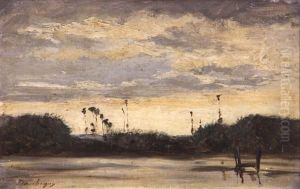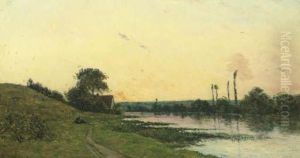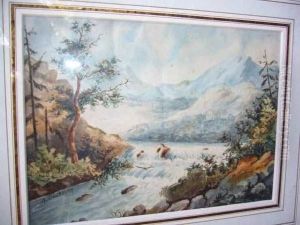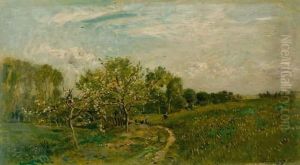Charles Amelie Daubigny Paintings
Charles-François Daubigny was a prominent French painter and one of the preeminent members of the Barbizon school, renowned for his landscape paintings and his significant influence on the Impressionist movement. Born on February 15, 1817, in Paris, France, Daubigny was exposed to the art world from an early age, thanks to his family's artistic background. His father, Edme François Daubigny, and his uncle, Pierre Daubigny, were both painters, which naturally led Charles to develop an interest in painting from a young age.
Daubigny began his formal art education under the guidance of his father and later studied at the École des Beaux-Arts in Paris. He started his career by painting traditional subjects but gradually shifted his focus towards landscapes. His early works were characterized by meticulous attention to detail and a profound appreciation for nature, traits that would define his entire oeuvre. In the 1840s, Daubigny began to travel extensively across Europe, including trips to Italy, the Netherlands, and various regions of France. These journeys had a profound impact on his work, leading him to adopt a more spontaneous and fluid style of painting, which was relatively innovative at the time.
Daubigny's landscapes were not just mere representations of nature; they were imbued with a sense of tranquility and a deep, emotional resonance. He often depicted the French countryside, rivers, and rural scenes with a delicate interplay of light and color, anticipating the Impressionist approach to capturing the fleeting moments of nature. One of his most innovative contributions to the art world was the use of a 'floating studio', a boat he converted into a studio, which allowed him to paint the Seine and Oise rivers' landscapes from an intimate, up-close perspective. This method not only provided him with unique vantage points but also deeply influenced the plein air (outdoor painting) practices of the Impressionists.
Throughout his career, Daubigny maintained a supportive relationship with younger artists, including Claude Monet and Camille Pissarro, encouraging their plein air practices and directly influencing their development as Impressionist painters. His work was widely exhibited, including at the prestigious Paris Salon, where he gained significant recognition and success.
Charles-François Daubigny passed away on February 19, 1878, in Paris. His legacy is profound, bridging the gap between the Barbizon school, with its emphasis on the realistic depiction of nature, and Impressionism, with its focus on light and color. Daubigny's innovative techniques, his pioneering plein air practices, and his dedication to capturing the essence of the landscape have cemented his place as a pivotal figure in the history of Western art.



